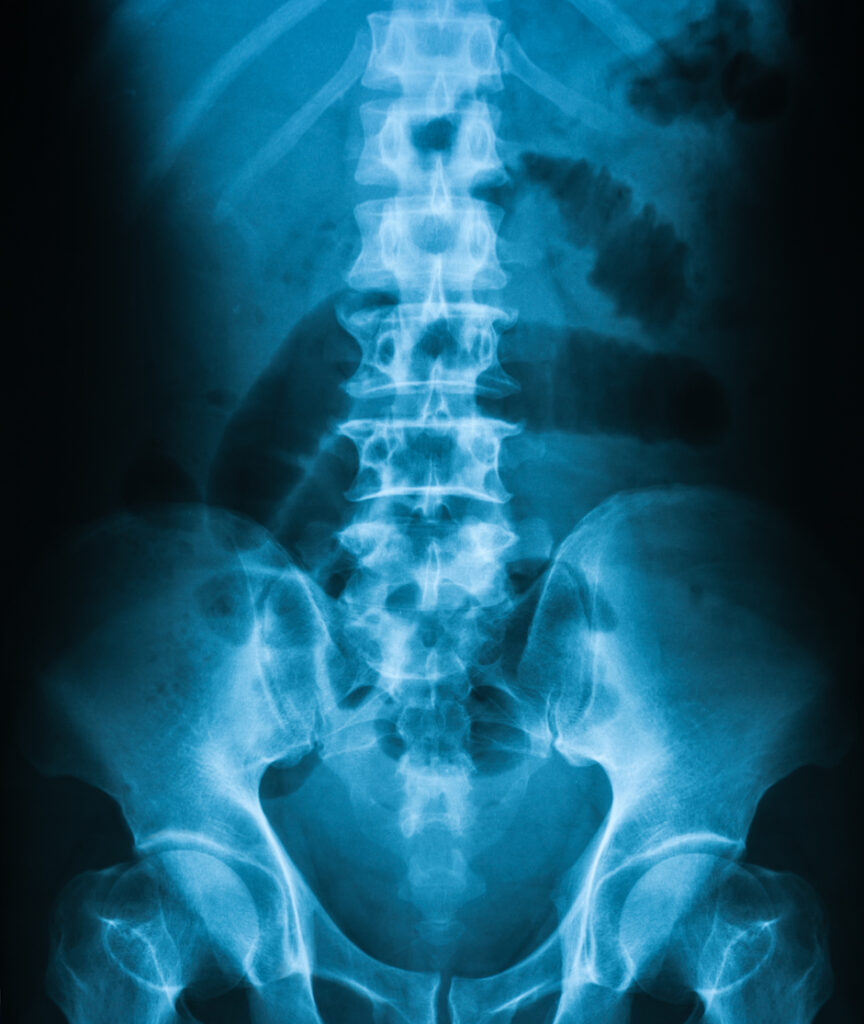An x-ray of the abdomen is a non-invasive imaging procedure used to examine the organs and structures within the abdomen, such as the stomach, intestines, liver, kidneys, and other related areas. It’s commonly used to help diagnose conditions like bowel obstructions, perforations, kidney stones, or certain types of infections. Here’s a step-by-step overview of the procedure:
1. Preparation
- Clothing: You will be asked to remove any clothing as well as any metal items such as jewelry, belts, or zippers that might interfere with the image.
- Hospital Gown: You may be given a hospital gown to wear during the procedure.
- Medical History: Inform the radiologic technologist if you’re pregnant or might be pregnant, as X-rays use ionizing radiation, which can pose risks during pregnancy. You should also inform them of any prior abdominal surgeries or conditions that might affect the results.
- Food and Drink: You typically are not asked to avoid eating or drinking beforehand unless for other radiology procedures like CT scans, MRI, Fluoroscopy and Ultrasounds.
2. Positioning
- Lying Down (Supine Position): The most common position for an abdominal X-ray is lying flat on your back on an X-ray table.
- Standing (Upright Position): Sometimes, you’ll be asked to stand for certain views, especially if there is a suspicion of air or fluid levels in the intestines (e.g., in cases of bowel obstruction or perforation).
- Side View (Lateral View): You may be asked to lie on your side for an additional lateral (side) view to provide more information or to visualize areas that may be harder to see in other positions.
- Chest X-ray: A chest x-ray might also be required
The radiologic technologist will carefully position you and may adjust the X-ray machine to focus on the specific area of your abdomen that needs imaging.
3. The X-ray Exposure
- Breathing Instructions: In most cases, you’ll be asked to hold your breath on expiration/exhalation briefly during the X-ray exposure to prevent any movement that could blur the images. This is typically done in both the standing and lying positions.
- Radiation Exposure: The X-ray machine sends a controlled amount of radiation through your abdomen to create an image on a special film or digital detector. The amount of radiation is very low and generally considered safe for adults. Pregnant women, however, are typically advised to avoid abdominal X-rays unless absolutely necessary.
4. The X-ray Process
- The X-ray itself is quick, usually taking only a few seconds per image. You may need a few different images (e.g., one in a supine position, one upright, and/or one lateral) depending on the physician’s needs.
- The technologist will leave the room while the X-ray is taken but will be able to observe you through a glass window. They’ll guide you through any breathing instructions or position changes.
5. Post-Procedure
- After the X-ray is taken, you can resume normal activities immediately, as there are no special recovery requirements.
- If you had to change into a gown, you could change back into your clothes.
6. Results
- The X-ray images will be reviewed by a radiologist, a doctor specialized in interpreting medical images. They will evaluate the images for any abnormalities such as tumors, organ enlargement, blockages, stones, or signs of infection.
- After the radiologist has reviewed the images, a report will be sent to the healthcare provider who ordered the test. You’ll typically discuss the results with your doctor during a follow-up appointment.
Common Reasons for an Abdominal X-ray
- Bowel Obstruction: To check for blockages in the intestines that may cause pain, vomiting, or constipation.
- Kidney Stones: To identify stones in the kidneys or ureters.
- Perforation: To look for signs of perforated organs (e.g., ruptured appendix or ulcers), which might show up as free air in the abdominal cavity.
- Fluid or Gas Levels: To assess abnormal amounts of fluid or gas in the intestines, which could indicate conditions like infection or obstruction.
- Abdominal Pain or Distension: To evaluate the cause of unexplained pain, bloating, or distension in the abdomen.
- Infections or Foreign Objects: Sometimes used to look for abnormal objects in the abdomen, such as swallowed items or signs of infection.

Considerations and Risks
- Radiation Exposure: Although the radiation used in an abdominal X-ray is minimal, it is still important to minimize unnecessary exposure, especially during pregnancy. If you’re pregnant, make sure to inform the healthcare team, and they may suggest alternatives, such as an ultrasound, if appropriate.
- Allergic Reactions: Unlike CT scans or MRIs, an abdominal X-ray does not typically require contrast materials, so the risk of an allergic reaction is much lower.
Conclusion
An abdominal X-ray is a relatively quick, straightforward procedure to help diagnose a variety of abdominal conditions. By following any specific instructions provided by your healthcare provider or radiologic technologist, you can ensure that the images are clear and accurate for proper diagnosis. If you have concerns, don’t hesitate to discuss them with the technician or your doctor prior to the procedure.

